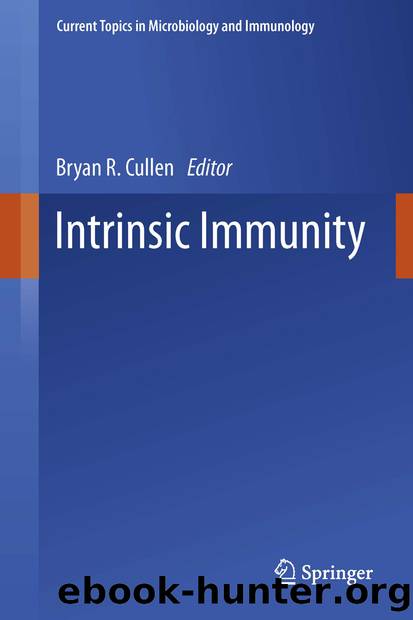Intrinsic Immunity by Bryan R. Cullen

Author:Bryan R. Cullen
Language: eng
Format: epub
Publisher: Springer Berlin Heidelberg, Berlin, Heidelberg
2.2 Limitations of dN/dS Analysis
Detection is more difficult when positive selection results in fixation of other classes of sequence change, such as insertions, deletions, recombination events, structural variation, or mutations in non-coding regions. Statistical methods for analyzing these kinds of changes are still being developed (for example, see (Haygood et al. 2010; Wong and Nielsen 2004) and have not been widely applied to the analysis of cellular RFs. A few examples of selection potentially altering non-coding sequences have appeared in the literature on RFs. For example, Diehl et al. surveyed insertions in the introns of primate TRIM5 and found an elevated rate of fixation of inserted LTR elements in the first and fourth introns, suggesting that these insertions may have been selected for altered regulation or transcription of the TRIM5 gene (Diehl et al. 2013). As another example, the novel TRIMCyp fusion protein found in several species of Asian macaques (Macaca sp) represents the de novo evolution of a new exon, a process that required two steps that were almost certainly selectively advantageous: the line-mediated insertion of a CypA reading frame downstream of the TRIM5 gene and elimination via a single-point mutation of the 3′ splice acceptor site for exon 7 of TRIM5 (Brennan et al. 2008; Brennan et al. 2007; Newman et al. 2008). The former created the coding sequence for a new exon, while the latter presumably permitted splicing to bypass exon 7 and exon 8 (which has subsequently accumulated missense mutations) and splice in-frame to the CypA insertion. Together, these mutations (one insertional and one a non-coding substitution) were likely subject to strong positive selection.
The SPRY domain of some TRIM5α orthologs in primates has differences in length due to expansions and contractions of short segments of sequence (Song et al. 2005). These regions overlap with clusters of positive selection, and site-directed mutagenesis indicates that determinants of target specificity can be found within the expanded sequences (Sawyer et al. 2005; Song et al. 2005; Wilson et al. 2008a). Thus, it is reasonable to assume that positive selection has at times favored changes in sequence due to insertions/duplications of sequence. Importantly, length variation and overlapping non-synonymous substitution make these regions especially prone to errors in sequence alignment and could artificially enhance dN/dS values for codons within these segments.
Claims of positive selection based on dN/dS of whole genes or individual codons implicitly assume that evolution proceeds in successive waves of mutation, selection, and fixation. A caveat to many studies is that each taxon (or species) is typically represented by a single allele, either cloned by RT-PCR or recreated based on a genome assembly. RF genes, like many immune system effectors, tend to be variable within species (polymorphism), a consequence of the same selective forces that cause them to be among the most variable genes between species (divergence). Much of the RF literature refers to “species-specific” restriction profiles, often based on testing of a single, representative ortholog. However, in cases where more extensive within-species sampling has occurred, it is not unusual to find significant non-synonymous polymorphism.
Download
This site does not store any files on its server. We only index and link to content provided by other sites. Please contact the content providers to delete copyright contents if any and email us, we'll remove relevant links or contents immediately.
| Administration & Medicine Economics | Allied Health Professions |
| Basic Sciences | Dentistry |
| History | Medical Informatics |
| Medicine | Nursing |
| Pharmacology | Psychology |
| Research | Veterinary Medicine |
Tuesdays with Morrie by Mitch Albom(4692)
Yoga Anatomy by Kaminoff Leslie(4306)
Science and Development of Muscle Hypertrophy by Brad Schoenfeld(4089)
Bodyweight Strength Training: 12 Weeks to Build Muscle and Burn Fat by Jay Cardiello(3915)
Introduction to Kinesiology by Shirl J. Hoffman(3725)
How Music Works by David Byrne(3187)
Sapiens and Homo Deus by Yuval Noah Harari(2987)
The Plant Paradox by Dr. Steven R. Gundry M.D(2547)
Churchill by Paul Johnson(2506)
Insomniac City by Bill Hayes(2498)
Coroner's Journal by Louis Cataldie(2432)
Hashimoto's Protocol by Izabella Wentz PharmD(2331)
The Chimp Paradox by Peters Dr Steve(2297)
The Universe Inside You by Brian Clegg(2097)
Don't Look Behind You by Lois Duncan(2080)
The Immune System Recovery Plan by Susan Blum(2029)
The Hot Zone by Richard Preston(1983)
Endure by Alex Hutchinson(1964)
Woman: An Intimate Geography by Natalie Angier(1882)
